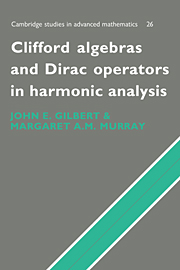Chapter 5 - Dirac operators and manifolds
Published online by Cambridge University Press: 23 November 2009
Summary
In this chapter we turn to the analysis of Clifford algebras and modules, together with an analysis of the associated Dirac operators, on Riemannian manifolds more general than the open subsets of Euclidean space studied in the previous chapter. Concepts from differential geometry are needed from the outset, but in keeping with the spirit of making the material available to more classically trained analysts we have attempted to minimize the use of differential geometric machinery, possibly at the expense of clarity and elegance. In the first section, therefore, Dirac operators are introduced explicitly on a single coordinate patch of a manifold. This serves several useful purposes. It helps bring out quite simply the role that the curvature of the manifold plays in the expression for D2. For the ‘flat’ case studied earlier, (–D2) was the Euclidean Laplacian, and solutions of DF = 0 were automatically harmonic: the forerunner of the GCR property of operators. But the fundamental Bochner–Weitzenböck theorem expresses (–D2) in general as a second-order Laplacian together with a zero-order curvature operator. This idea is a basic one throughout the chapter. In the specific examples of the spinor Laplacian and the Hodge Laplacian, the curvature operator is explicitly calculated. By assuming that the coordinates form a normal coordinate system, we also express (–D2) asymptotically as a sum of an operator, which will play a fundamental role in the proof of the Atiyah–Singer index theorem, and a remainder operator.
Section 2 deals with the problem of passing from a local setting to a global setting.
Information
- Type
- Chapter
- Information
- Clifford Algebras and Dirac Operators in Harmonic Analysis , pp. 247 - 320Publisher: Cambridge University PressPrint publication year: 1991
